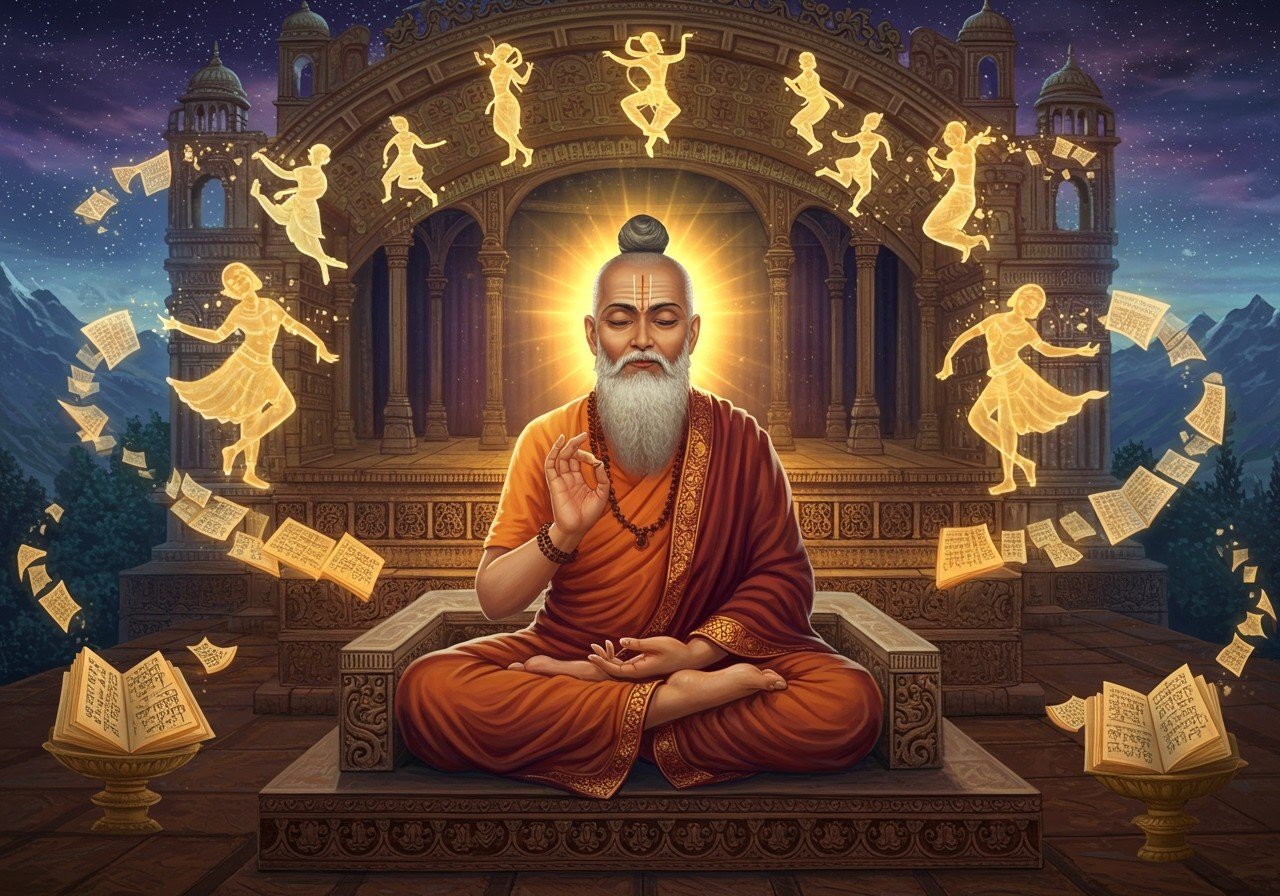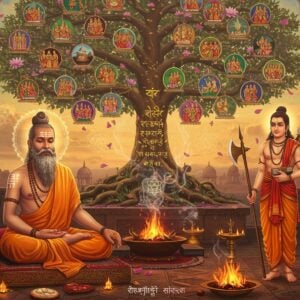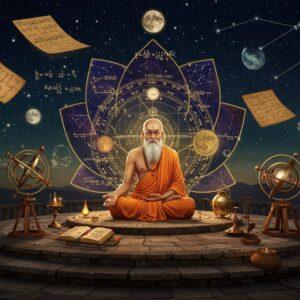
Abhinavagupta’s commentary on the Natya Shastra, known as the Abhinavabharati, is an invaluable resource for those captivated by Sanskrit drama and theatre. This profound work unveils the intricacies of Indian classical arts, offering a glimpse into the rich tapestry of ancient performances. Let’s delve into the key aspects and historical context that elevate this commentary to its esteemed position.
The Enduring Legacy of Abhinavagupta
Abhinavagupta, a celebrated polymath, transcended the boundaries of philosophy, excelling in diverse fields such as Tantra and the arts. His profound influence on Indian aesthetics continues to resonate with scholars and artists alike. His magnum opus, the Abhinavabhārati, stands as a cornerstone of commentary tradition. Across centuries, his ideas have been meticulously preserved, inspiring countless individuals drawn to the allure of Indian classical arts. His contributions to Indian aesthetics laid the groundwork for future discourse and shaped the very understanding of artistic expression. His profound influence on subsequent scholars solidified his position as a leading figure in the field, and the Abhinavabhārati continues to be a source of profound insights for generations of scholars.
- Contributions to Indian aesthetics shaped the discourse on art and expression.
- Influence on later scholars solidified his place as a leading figure in the field.
- Importance of Abhinavabhārati as a foundational text in commentary tradition.
Comprehending Abhinavagupta’s contributions provides a deeper appreciation for his transformative impact on Indian aesthetics and philosophy.
Abhinavabharati: A Comprehensive Commentary
The Abhinavabharati is a treasure trove for enthusiasts of Sanskrit drama and theatre. Authored by Abhinavagupta, a Kashmiri Saivite spiritual leader and yogi (c. 950–1020 CE), it represents the oldest surviving commentary on Bharata Muni’s Natyashastra, an ancient treatise on performing arts dating back to between 200 BCE and 200 CE. In April 2025, the Abhinavabharati was inscribed into UNESCO’s Memory of the World Register, underscoring its global significance within the realm of arts and culture. This recognition further solidifies its importance for scholars and practitioners of Indian classical arts worldwide.
Commentary and Interpretation
Transcending the conventional role of a commentary, the Abhinavabharati stands as an independent scholarly work, delving into the multifaceted aspects of drama, dance, poetry, music, art, prosody, and aesthetics. Drawing upon Anandavardhana’s Dhvanyaloka, Abhinavagupta introduces novel perspectives, enriching the discourse. His interpretations occasionally diverge from Bharata Muni’s, showcasing original concepts and insights rooted in his extensive experience and profound understanding of contemporary practices. These unique perspectives offer a fresh lens through which to examine the Natyashastra’s principles.
Rasa Theory
At the heart of Abhinavagupta’s work lies the elucidation of Bharata’s rasasutra, the theory of aesthetic experience within dramatic arts. Seamlessly integrating this with Anandavardhana’s theory of abhivyakti (expression), and drawing upon the tenets of Kashmir’s Pratyabhijna philosophy, Abhinavagupta proposes that aesthetic experience is a manifestation of the self’s inherent dispositions, encompassing emotions like love and sorrow. He posits that this experience is characterized by a contemplative immersion in the bliss of the self, a state of profound aesthetic enjoyment. This intricate interplay of philosophical concepts provides a nuanced understanding of rasa theory.
Influence on Sanskrit Drama
The fundamental aim of Sanskrit drama is to evoke a specific rasa, or sentiment, within the audience, ranging from the erotic and heroic to the pathetic. The Abhinavabharati underscores this objective, emphasizing how plot and character development contribute to the awakening of these sentiments. By illuminating the mechanisms through which drama impacts the audience’s emotional landscape, Abhinavagupta’s insights have profoundly shaped the understanding and appreciation of Sanskrit drama. This focus on emotional impact continues to inform interpretations of Sanskrit plays today.
Historical Context
Abhinavagupta enriches his commentary by incorporating insights into the works of scholars who predate him, many of whose writings are now lost to time. He engages with the perspectives of Utpaladeva, Bhatta Lollata, Srisankuka, Bhatta Nayaka, and his guru Bhatta Tauta. This meticulous engagement with historical perspectives transforms the Abhinavabharati into an invaluable resource for tracing the evolution of dramatic theory across different eras. It provides a crucial link to understanding the historical development of thought in this field.
Minor Dramas
Abhinavagupta sheds light on less prominent dramatic categories such as nrtta-kavya and raga-kavya, which emphasize dance and music respectively – concepts absent in the original Natyashastra. Furthermore, he elaborates on various dance forms like bhadrasana, offering insights that broaden the scope of classical Indian theatre. This attention to detail expands our understanding of the diversity and richness of ancient Indian performance practices. He provides detailed descriptions that enhance our knowledge of these lesser-known forms.
Poojn.in: Your Companion on the Journey of Cultural Exploration
For those seeking to deepen their understanding of ancient Indian traditions and rituals, poojn.in offers a wide array of products that can enrich your experience. Whether you’re looking for authentic puja items, sacred texts, or spiritual accessories, poojn.in has something for everyone. Visit www.poojn.in today and embark on a journey of cultural discovery.
Looking to enhance your understanding of the Natyashastra and Abhinavagupta’s commentary? Consider exploring these relevant products available on poojn.in:
- Srimad Bhagavad Gita (Bengali Version) : Delve into the philosophical depths of the Gita, a text that complements the study of ancient Indian thought.
- Kalash, Kumkum & Roli: These traditional items are often used in rituals and ceremonies associated with learning and scholarship.
- Hawan Samagri: Create a sacred and conducive atmosphere for study and reflection with this traditional offering material.
Continuing the Legacy in the Digital Age
The Abhinavabharati serves as a beacon, illuminating the world of Sanskrit drama and theatre. Its timeless wisdom forges a connection to a rich heritage, offering profound insights that resonate even in contemporary times. As a growing number of individuals explore this ancient text, Abhinavagupta’s interpretations bridge the chasm between past and present. By seamlessly weaving together philosophical depth with practical theatrical guidance, it stands as an enduring resource for artists and scholars alike. Embracing the accessibility offered by digital platforms, we honor Abhinavagupta’s legacy, ensuring that his teachings continue to inspire and enlighten generations to come. The increased availability of these texts online allows for a wider dissemination of knowledge and appreciation of this ancient art form.
Frequently Asked Questions about Abhinavabharati
What is the relationship between Abhinavagupta and the Natyashastra? Abhinavagupta, a renowned philosopher and scholar, composed a comprehensive commentary on the Natyashastra, delving deeper into its intricacies and expanding upon its teachings. This commentary, known as Abhinavabharati, offers invaluable insights into the Natyashastra’s principles.
Why is Abhinavagupta’s commentary crucial for understanding the Natyashastra? His commentary elucidates complex concepts, bridging the gap between ancient teachings and contemporary understanding. It offers a scholarly interpretation that unlocks the deeper meanings within the Natyashastra.
Did Abhinavagupta integrate Buddhist concepts into his commentary? Primarily rooted in the Shaiva tradition, Abhinavagupta engaged with various philosophies, including Buddhism. However, his Natyashastra commentary primarily reflects his Shaiva philosophical insights.
How does Abhinavagupta’s interpretation deviate from the original Natyashastra? While the Natyashastra focuses on the technical aspects of performing arts, Abhinavagupta’s commentary explores the philosophical and spiritual dimensions, providing a more holistic understanding.
What are some central themes in Abhinavagupta’s commentary? Key themes encompass the aesthetics of rasa, the spiritual aspects of performance, and the significance of audience experience in the performing arts.
How has Abhinavagupta shaped modern interpretations of the Natyashastra? His interpretations have profoundly influenced modern understandings of Indian performing arts, emphasizing the emotional and spiritual connection between performer and audience.
Are English translations of Abhinavagupta’s commentary available? Yes, translations exist, making his insights accessible to a broader audience and facilitating a wider appreciation of his scholarly contributions. You can explore more about Sanskrit mantras and Prasad recipes on poojn.in. Here are the links to related articles you may find helpful – Prasad Recipes & Sanskrit Mantras. Also take a deep dive in Ramcharitmanas and Hanuman Chalisa on poojn.in.


